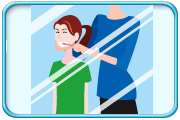Teaching Children About Privacy..
Privacy is a complicated and a tricky topic for children . As for them children shades of gray have not yet been discovered, verbal filters are often absent. What is the difference between the milkman and the teacher? Who should you share certain information with? This can be so confusing unless you can find a clear way to explain the concept in a manner that is appropriate for their developmental level.
MAKE YOUR OWN PRIVACY CIRCLE OF FAMILY AND FRIENDS.
Making a privacy circle with your child can save you from many awkward moments. How many times has your child embarrassed you by blurting out personal information to a stranger? Or telling a neighbor that you barely know, that you are going out on a vacation? It is not surprising when a child at school , or at therapy sessions will start to tell us about an argument their parents had or how their dad burp really loudly at dinner. However, this information is neither helpful nor appropriate for us to know. Beyond making embarrassing remarks, “Stranger Danger” is also an important lesson to teach our children. But rather than frightening or embarrassing them, we prefer to make it really clear what is appropriate to share with the different people the children may encounter. To help children understand what to share, Ioften use Privacy Circles to explain this confusing concept.
Get the Kids Involved!
To make a privacy circle that is relevant to them, the child should be involved in deciding who is in their circles. They may feel more comfortable sharing their secrets with a friend rather than an aunt or uncle.
The first step is to fill in the circles with the people in their lives. The centre circle is the child and the outer circle is strangers. For children, the circle around them is always their parents ,but for teenagers, the second circle may be their best friend.
Talk About Different Situations Where Privacy Needs to be Considered..
Once the circles are filled in, it is time to start defining what that means. Give examples of different situations and topics. You can write these on a post-it note and stick it in the appropriate circle. Talk about who you might say these things to and why. Talk about how they would feel if you shared something that was private to them with the maid or someone else out their close privacy circles. Here are some examples of things that you can talk about:
· Who do you wave hello to?
· Who would you tell your name?
· Who would you tell your address?
· Who would you tell where you go to school?
· Who would you tell what sports you like to play?
· If you have a problem at school, who would you tell?
· Who can touch you?
· Who would you tell, “My poo makes my bottom itch.”
· Who would you invite to your home?
· Who would you tell, “My parents got into a fight last night.”
· Who, if anyone, would you tell, “My mom doesn’t like your mom.”
· Who would you share a secret with?
· Who would you share that you are going for a vacation?
· Who would you tell about how many members live in your house?
· Who would you share your parents details with?
It is best to use the privacy circle on daily basis.
stick it on a wall or hang it on a door knob. Whenever a situation occurs that is a teachable moment about privacy and sharing have them add it to their privacy circle. If a child starts to share something that they probably should not, just interrupt them and ask if it belongs in your part of their privacy circles. Remind them how they feel when someone shares something personal about them.
I hope it helps :)












































